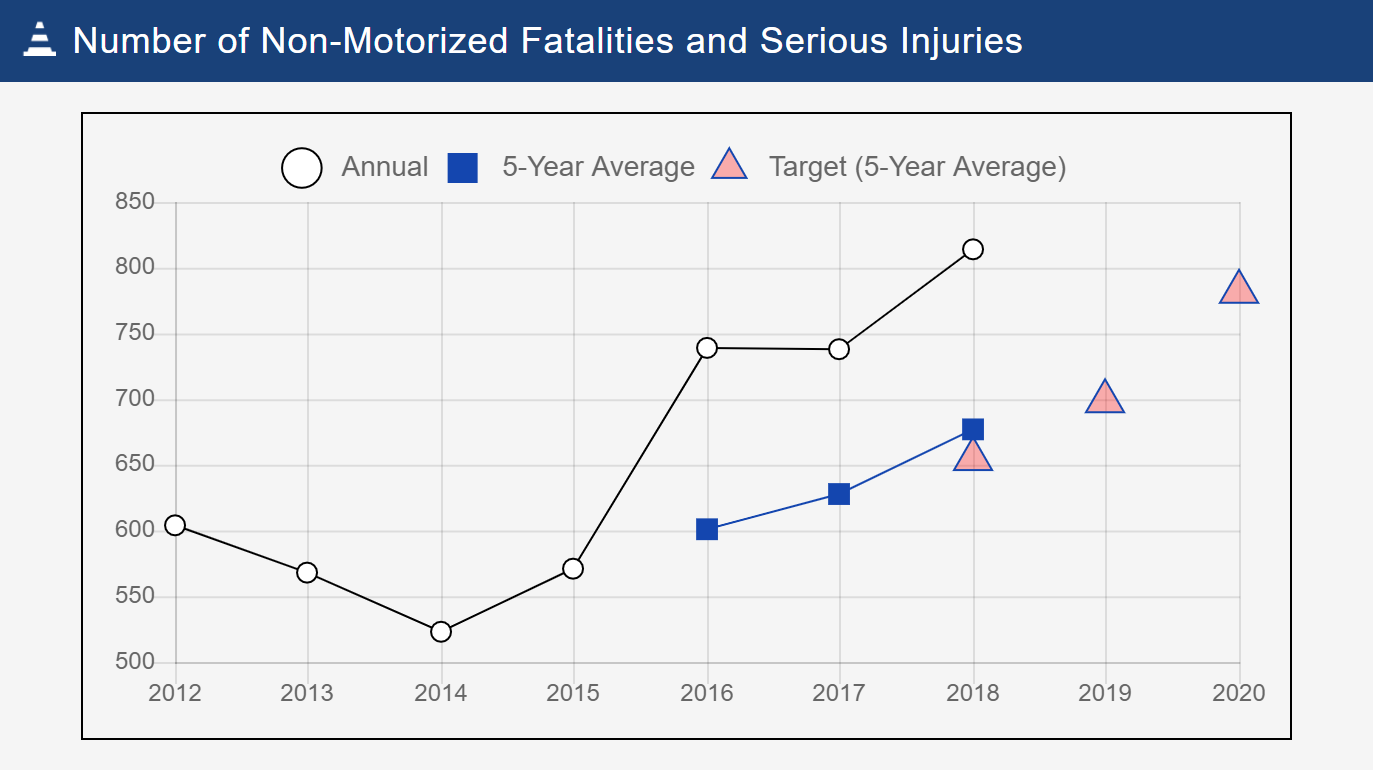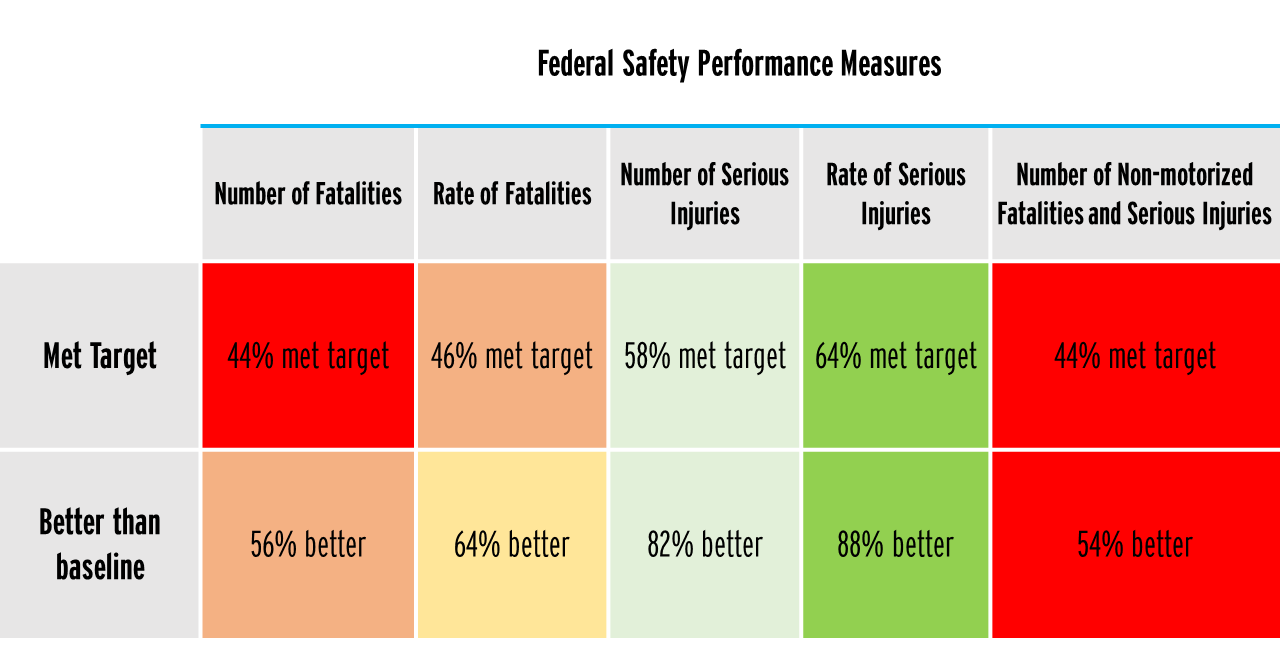State Safety Targets Show Need For Congress To Further Prioritize Safety
The following blog post is co-authored and published in partnership with the National Complete Streets Coalition, a non-profit, non-partisan alliance of public interest organizations and transportation professionals committed to the development and implementation of Complete Streets policies and practices and a program of Smart Growth America.
Transportation policy can take a long time. In 2012, Congress passed the Moving Ahead for Progress in the 21st Century Act (MAP-21) which required the US Department of Transportation (US DOT) to establish a safety performance measure to assess federal investments in transportation. In 2016, the Obama administration promulgated a final rule. And now, in 2020 the US DOT has assessed state safety performance measures.
Most transportation advocates believe that performance measures are critically important to the future of federal transportation policy. Performance measures require data collection by states, regular reporting assessed by US DOT, and result in financial impacts for states that do not meet performance targets. While this concept is pretty simple, it is a profound shift in transportation policy towards accountability. It is also more important than ever in 2020, as the rate of roadway fatalities jumped 20 percent, even though driving was down 17% due to Coronavirus-related travel restrictions
Non-motorized safety performance measures were opposed by 23 state DOTs and the American Association of State Highway Transportation Officials. They exist thanks to the work of many advocates, including nearly 10,000 individuals who contacted the Federal Highway Administration (FHWA) during the rulemaking process.
The Good News: In every year that states have set safety targets, most states have set targets that would reduce non-motorized fatalities and serious injuries. Even better, the number of states targeting a reduction has increased every year. If state DOTs are serious about reaching zero traffic deaths, this trend must continue and they must do more to make these targets come true.
The Bad News: Many states are setting safety targets that anticipate more people dying or being seriously injured while biking and walking. In 2020, twenty states set safety targets of more deaths and serious injuries. For 2018 targets, six states exceeded even their grim targets of increased fatalities and serious injuries. At least ten states have targets that are clearly trending up, sometimes dramatically, including in states with very poor safety records for people biking and walking. This implies that those states do not have a serious theory for reducing non-motorized fatalities and serious injuries or are not serious about reaching zero traffic deaths. And these bad targets are in the context of the US making much less progress on traffic deaths than peer countries.

Pennsylvania’s safety targets versus average fatalities and serious injuries
For example, Pennsylvania has never set a non-motorized safety target that was lower than the 5-year baseline average for fatalities and serious injuries. The FHWA assessment was that Pennsylvania has not met its target or made significant progress. The state’s targets have trended up significantly, implying that the state has no serious plans to reverse its poor performance.
A little more than a third of the states that FHWA found met their safety performance target across all modes had higher levels of non-motorized fatalities and serious injuries than their 5-year baseline average. This means that despite data showing that people who bike and walk are less safe, these states will not be incentivized to spend Highway Safety Improvement Program funds on safety improvements for people who bike and walk.
Safety Performance Target Assessments
The FHWA cautions against drawing conclusions based upon its safety performance target assessments. Each state sets its target in a unique way and missing a target may mean different things in different states. Sometimes these differences are notable, like Florida setting a target of zero, although the state has no chance of meeting that target (the state of Florida also notes by their own target that they expected the rate of driving to have a greater impact on safety than anything else).
We believe that there are still lessons to be learned from comparing state targets assessments and here are a few.
1. THE NON-MOTORIZED SAFETY PERFORMANCE TARGET WAS THE WORST PERFORMING SAFETY TARGET.
More states failed to meet their target and more states failed to improve relative to their baseline than any other type of target.

2. ONLY 4 STATES – DELAWARE, HAWAII, RHODE ISLAND, AND VERMONT – SET A GOAL TO DECREASE NON-MOTORIZED FATALITIES AND SERIOUS INJURIES AND ACHIEVED IT.
This low rate of meeting reduction targets is unlikely to be due to overly ambitious targets (like Florida’s target of zero) because more than 75% of the states that missed their target to reduce non-motorized fatalities and serious injuries performed worse than their 5-year baseline average.

3. ONLY 32% OF STATES PERFORMED BETTER THAN THEIR 5-YEAR BASELINE AVERAGE.
This is understandable given that pedestrian and bicyclist deaths hit 30-year highs in the period assessed, but highlights the widespread nature of pedestrian and bicyclist safety problems.

4. FOUR OF THE FIVE STATES WITH THE MOST BICYCLIST AND PEDESTRIAN FATALITIES – CALIFORNIA, FLORIDA, NEW YORK, TEXAS, AND GEORGIA – PERFORMED WORSE THAN THEIR 5-YEAR BASELINE AVERAGE.
New York was the only state to improve upon its average. Florida and Georgia were the only states in this group that set targets to improve.
States that fail to meet their own targets (some of which are targets to have less safe roadways) suffer very minor consequences – all states have to do is spend safety funds on safety projects and submit an implementation plan. But for the first time, thanks to Congress requiring performance measures, we can see how they are performing and hold them to account.
For decades, many departments of transportation (like Florida stated in their safety report) and transportation experts have claimed that increases in driving dictate increases in traffic fatalities and serious injuries. This claim allows transportation agencies to treat traffic fatalities somewhat like weather events — outside of their control. However during the COVID-19 pandemic, we have seen that this claim cannot be true. The National Safety Council found in the first 6 months of 2020, the rate of roadway fatalities jumped 20 percent, even though driving was down 17%. Transportation agencies must recognize their responsibility to make safe systems rather than claiming they are powerless to make roads safer.
The United States has reached a point where the transportation sector is the go-to example of a sector where deaths are tolerated. Congress, and decision makers at all levels of government, need to take decisive action to reorient the transportation sector to prioritize safety. The House INVEST Act took important steps to prioritize safety and Congress should build upon those steps in the future.